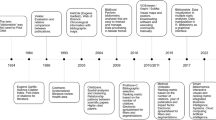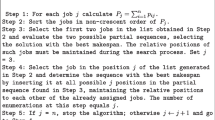Abstract
We report OST experience on macro-indicators producing, especially on academic science and ISI sources. This task requires a combination of organizational choices for data handling and processing, and of bibliometric choices for a selection of indicators appropriate to the missions. Both aspects are briefly studied: the OST database, which also contains nonbibliometric datasets, is organized on the relational principle (RDBMS). Bibliometric indicators selected are classical ones, with a stress on overall coherence. In conclusion, standardization issue is briefly discussed. Standardization may not be desirable at the same extent for different targets (data, nomenclatures, indicators, procedures, etc.) and must not hinder further research. Natural process of communication and explication may also lead to fruitful convergences, without freezing supposed “best ways”.
Similar content being viewed by others
References
H.F. Korth, A. Silberschatz,Database System Concepts, McGraw Hill, 1986.
H. Tardieu, A. Rochfield, R. Coletti, La méthode MERISE, I,II, Editions d'Organisation, 1983, 1985.
S. Katz, Desktop scientometrics,Proceedings of 5th Int. Conf. on Scientometrics and Informetrics, River Forest, Ill, June 7–10, Learned Information Inc., Medford, 1995.
F. Narin, Evaluative bibliometrics; the use of publication and citation Analysis in the evaluation of scientific activity, National Science Foundation, 1976.
A.F.J. van Raan (Ed.),Handbook of Quantitative Studies of Science and Technology, Elsevier, 1988.
A. Schubert, W. Glänzel, T. Braun, Scientometric datafiles. A comprehensive set of indicators on 2649 journals and 96 countries in all major science fields and subfields, 1981–1985,Scientometrics, 16 (1989) 3–478.
H.F. Moed, R.E. de Bruin, A.J. Nederhof, A.F.J. van Raan, R.J.W. Tijssen,State of the Art of Bibliometric Indicators, an Overview of Demand and Supply, CEC MONITOR/SPEAR EUR 14582 EN, 1992.
B.R. Martin, The bibliometric assessment of UK scientific performance. A reply to Braun, Glänzel and Schubert,Scientometrics, 20 (1991) 333–357.
T. Braun, W. Glänzel, A. Schubert, The bibliometric assessment of UK scientific performance —some comments on Martin's reply,Scientometrics, 20 (1991) 359–362.
L. Leydesdorff, On the “scientometric decline of British science. One additional graph in reply to Ben Martin,Scientometrics, 20 (1991) 363–367.
OST, Science & Technologie — Indicateurs 1994, Economica.
M.P. Carpenter, F. Narin, Clustering of scientific journals,JASIS, 24 (1973) 425–536.
R.J.W. Tijssen, J. de Leeuw, A.F.J. van Raan, Quasi-correspondence analysis on square scientometrics matrices,Scientometrics, 11 (1987) 347–361.
L. Leydesdorff, S.E. Cozzens, The delineation of specialties in terms of journals using the dynamic journal set of the SCI,Scientometrics, 26 (1993) 135–156.
S. Katz, D. Hicks, The classification of interdisciplinary journals: A new approach,5th Int. Conf. on Scientometrics and Informetrics, River Forest, Ill, June 7–10, Learned Information Inc., Medford, 1995, 245–254.
H. Grupp, S. Hinze, International orientation efficiency of and regard for research in East and West Germany: a bibliometric investigation of aspects of technology genesis in the United Germany,Scientometrics, 29 (1994) 83–113.
D. Lindsey, Production and citation measures in the sociology of science: the problem of multiple authorship,Social Studies of Science, 10 (1980) 145–162.
OST, Science & Technologie — Indicateurs 1996, Economica (forthcoming).
L. Egghe, R. Rousseau,Introduction to Informetrics, Quantitative Methods in Library, Documentation and Information Science, 1990, Elsevier.
T. Luukkonen, R.J.W. Tijssen, G. Persson, G. Sivertsen, The measurement of international scientific collaboration,Scientometrics, 28 (1993) 15–36.
T. Braun, E. Bujdoso, Gatekeeping patterns in the publication of analytical chemistry research,Talanta, 30 (1983) 161–167.
UNIPS-CNRS, Indicateurs de Politique Scientifique No3, CNRS, 1995.
W. Glänzel, U. Schoepflin, Little scientometrics, big scientometrics... and beyond?Scientometrics, 30 (1994) 375–384.
R. Barre, R. Do not look for scapegoals! Link bibliometrics to social sciences and address societal needs,Scientometrics, 30 (1994) 419–424.
J.F. Miquel, Y. Okubo, Indicators to measure internationalization of science, OCDE Conference, July 2–5, 1990.
Author information
Authors and Affiliations
Rights and permissions
About this article
Cite this article
Zitt, M., Teixeira, N. Science macro-indicators: some aspects of ost experience. Scientometrics 35, 209–222 (1996). https://doi.org/10.1007/BF02018479
Received:
Issue Date:
DOI: https://doi.org/10.1007/BF02018479




